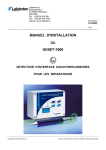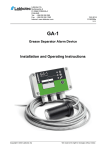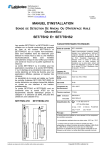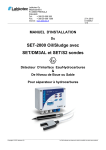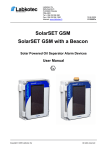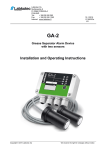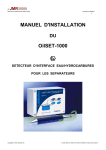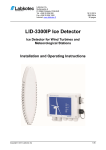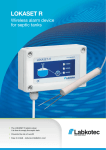Download Operating instructions Kana 1
Transcript
Labkotec Oy Myllyhaantie 6 FI-33960 PIRKKALA FINLAND Tel: +358 29 006 260 Fax: +358 29 006 1260 Internet: www.labkotec.com 16.3.2012 D15530_e 1/12 OMS-1 Oil Separator Alarm Device Installation and Operating Instructions Copyright © 2012 Labkotec Oy We reserve the right for changes without notice OMS-1 Oil Separator Alarm Device Installation and Operating Instructions D15530_e TABLE OF CONTENTS 1 GENERAL ............................................................................................................ 3 2 INSTALLATION ................................................................................................... 4 2.1 OMS-1 control unit ....................................................................................... 4 2.2 OMS sensor ................................................................................................. 5 2.3 Cable joint .................................................................................................... 5 3 OPERATION ........................................................................................................ 6 3.1 Modes of operation ...................................................................................... 6 4 TROUBLE-SHOOTING ....................................................................................... 8 5 REPAIR AND SERVICE ...................................................................................... 9 6 SAFETY INSTRUCTIONS ................................................................................... 9 7 TECHNICAL DATA ............................................................................................ 10 APPENDIX 1. OMS SYSTEM DRAWING .............................................................. 11 SYMBOLS Warning / Attention Pay special attention to installations at explosive atmospheres Device is protected by double or reinforced insulation Copyright © 2012 Labkotec Oy 2/12 We reserve the right for changes without notice OMS-1 Oil Separator Alarm Device Installation and Operating Instructions 1 D15530_e GENERAL OMS-1 is an alarm device for monitoring the thickness of the oil layer accumulating in an oil separator. The system consists of OMS-1 control unit, OMS sensor and a cable joint. Figure 1. Oil separator supervision with OMS-1 alarm device OMS sensor is installed into the light liquid storage chamber and gives an alarm when the chamber oil layer reaches a pre-determined level. The sensor is normally immersed in water. The function is based on the measurement of the electrical conductivity of the surrounding liquid – water conducts electricity much better than oil. Oil separator is regarded as potentially explosive (Ex) area. OMS-1 sensor can be installed in a zone 0, 1 or 2 potentially explosive area but the control unit must be mounted in a safe area. The LED indicators, push button and interfaces of the OMS-1 control unit are described in figure 2. Figure 2. OMS-1 control unit - features Copyright © 2012 Labkotec Oy 3/12 We reserve the right for changes without notice OMS-1 Oil Separator Alarm Device Installation and Operating Instructions 2 2.1 D15530_e INSTALLATION OMS-1 control unit OMS-1 control unit can be wall-mounted. The mounting holes are located in the base plate of the enclosure, beneath the mounting holes of the front cover. The connectors of the external conductors are isolated by separating plate. The plate must not be removed. The cover of the enclosure must be tightened so, that the edges touch the base frame. Only then does the push button function properly and the enclosure is tight. Before installation, please read the safety instructions in chapter 6! Figure 3. OMS-1 alarm device installation. Copyright © 2012 Labkotec Oy 4/12 We reserve the right for changes without notice OMS-1 Oil Separator Alarm Device Installation and Operating Instructions 2.2 D15530_e OMS sensor OMS sensor should be installed as described in figure 3. The sensor gives an alarm when the upper electrode is in oil. Please check the correct installation depth also from the instructions of the oil separator. 2.3 Cable joint Fig. 4 Cable joint Connections of the sensor cable inside the cable joint are explained in figure 3. If shielded cable is used cable shields and possible excess wires need to be connected to the same point in galvanic contact. Please make sure, that the sensor and cable between OMS-1 control unit and the sensor do not exceed the maximum allowed electrical parameters – see chapter 7 Technical data. IP rating of the cable joint is IP68. Make sure, that the cable joint is closed properly. Notice in cabling: Risk of electrostatic charging! If the sensor cable must be extended and there is a need for equipotential grounding, it should be done with the junction box LJB2. The cabling between the OMS-1 control unit and the junction box should be done with a shielded twisted pair instrument cable. Maximum cable length is 100 m. Copyright © 2012 Labkotec Oy 5/12 We reserve the right for changes without notice OMS-1 Oil Separator Alarm Device Installation and Operating Instructions 3 D15530_e OPERATION The operation of the alarm device should be checked always after the installation. Also check the operation always when emptying the separator or at least once every six months. Functionality test 1. Immerse the sensor into water. The device should be in normal mode. 2. Lift the sensor up in air or oil. An Oil alarm should be generated (see chapter 3.1 for more detailed description). 3. Clean up the sensor. 4. Immerse the sensor back into water. The alarm should go off after a delay of 10 sec. A more detailed description of the operation is provided in chapter 3.1. If the operation is not as described here, check connections and cabling. If necessary contact a representative of the manufacturer. 3.1 Modes of operation Normal mode – no alarms Oil alarm Sensor is totally immersed in water. Mains LED indicator is on. Other LED indicators are off. Relay is energized. Sensor is immersed in oil. (the sensor gives an alarm when the upper electrode is in oil). Mains LED indicator is on. Oil Alarm LED indicator is on. Buzzer on after 10 sec delay. Relay de-energize after 10 sec delay. (Note. The same alarm takes place when OMS sensor is in the air.) After removal of an alarm, the Oil Alarm LED indicator and buzzer will be off, and relay will be energized after 10 sec delay. Fault alarm Reset of an alarm Copyright © 2012 Labkotec Oy Sensor cable break, short circuit or a broken sensor. Mains LED indicator is on. Sensor circuit Fault LED indicator is on after 10 sec delay. Buzzer is on after 10 sec delay. The relay de-energize after 10 sec delay. When pressing the Reset/Test push button. Buzzer will go off. If the buzzer is not reset, it goes off automatically after three days. 6/12 We reserve the right for changes without notice OMS-1 Oil Separator Alarm Device Installation and Operating Instructions D15530_e TEST FUNCTION Test function provides an artificial alarm, which can be used to test the function of the OMS-1 alarm device and the function of other equipment, which are connected to OMS-1 via its relay. Attention! Before pressing the Reset/Test button, make sure that the change of relay status does not cause hazards elsewhere! Normal situation When pressing the Reset/Test push button: Oil Alarm and Fault LED indicators are immediately on. Buzzer is immediately on. Relay de-energize after 2 sec of continuous pressing. When the Reset/Test push button is released: LED indicators and buzzer go immediately off. Relay energize immediately. Alarm on When pressing the Reset/Test push button for the first time: Buzzer will go off. When pressing the Reset/Test push button after that: Fault LED indicator is immediately on. Oil Alarm LED indicator remains on. Buzzer remains on. If it has been reset earlier, it will return to be on. When the Reset/Test push button is released: The device returns right away to the preceding status. Fault alarm on Copyright © 2012 Labkotec Oy When pressing the Reset/Test push button: The device does not react to the test at all. 7/12 We reserve the right for changes without notice OMS-1 Oil Separator Alarm Device Installation and Operating Instructions 4 D15530_e TROUBLE-SHOOTING Problem: Possible reason: To do: MAINS LED indicator is off Device doesn’t get supply voltage. 1. Check that power separation switch is not switched off. 2. Measure the voltage between poles N and L1. It should be 230 VAC + 10 %. Problem: Possible reason: To do: Problem: No alarm when sensor in oil or air, or the alarm will not go off Sensor is dirty. 1. Clean-up the sensor and check the operation again. FAULT LED indicator is on Possible reason: Resistance in sensor circuit too high (cable break or out of connector) or too low (cable in short circuit). The sensor might also be broken. To do: 1. Make sure, that the sensor cable has been connected correctly to the OMS-1 control unit. 2. Disconnect sensor’s [+] wire and measure resistance between [+] and [-] wires. The measured resistance should be 46-48 kΩ. 3. If it is possible measure also resistance between [+] wire and sensor’s upper electrode. The measured resistance should be 1,1 – 1,3 kΩ. 4. If the resistance values in items 2 and 3 are correct, then OMS-1 control unit is defective, otherwise problem is in cabling or in sensor. If the problem can not be solved with the above instructions, please contact Labkotec Oy’s service. Attention! If the sensor is located in an explosive atmosphere, the multimeter must be Exi-approved! Copyright © 2012 Labkotec Oy 8/12 We reserve the right for changes without notice OMS-1 Oil Separator Alarm Device Installation and Operating Instructions 5 D15530_e REPAIR AND SERVICE The sensor should be cleaned and the operation should also be tested when emptying the oil storage chamber or at least once every six months. The easiest way to check the operation is to lift the sensor up in the air and to put it back to the separator. The operation is described in chapter 3. For cleaning, a mild detergent (e.g. washing-up liquid) and a scrubbing brush can be used. In case of queries, please contact Labkotec Oy’s service: [email protected]. 6 SAFETY INSTRUCTIONS OMS-1 control unit must not be installed in potentially explosive atmosphere. Sensors connected to it may be installed in zone 0, 1 or 2 potentially explosive atmospheres. In case of installations in explosive atmospheres the national requirements and relevant standards as IEC/EN 60079-25 and/or IEC/EN 60079-14 must be taken into account. Warning! If the cabling is voltage-tested, the sensor must be disconnected. If electrostatic discharges can cause hazards in the operating environment, the device must be connected into equipotential ground according to requirements with regards to explosive atmospheres. Equipotential grounding is made by connecting all conductive parts into same potential e.g. at the cable junction box. Equipotential ground must be earthed. The device does not include a mains switch. A two pole mains switch (250 VAC 1 A), which isolates both lines (L1, N) must be installed in the main power supply lines in the vicinity of the unit. This switch facilitates maintenance and service operations and it has to be marked to identify the unit. When executing service, inspection and repair in explosive atmosphere, the rules in standards IEC/EN 60079-17 and IEC/EN 60079-19 about instructions of Ex-devices must be obeyed. Copyright © 2012 Labkotec Oy 9/12 We reserve the right for changes without notice OMS-1 Oil Separator Alarm Device Installation and Operating Instructions 7 D15530_e TECHNICAL DATA OMS-1 control unit OMS sensor Dimensions 125 mm x 75 mm x 35 mm (L x H x D) Principle of operation Measurement of conductivity Enclosure IP 65, material polycarbonate Material PVC, AISI 316 Operation temperature -30 ºC…+50 ºC IP-classification IP68 Supply voltage 230 VAC ± 10 %, 50/60 Hz The device is not equipped with a mains switch Temperature Operation: 0 ºC…+60 ºC Safety: -30 ºC …+60 ºC Power consumption 1 VA Cable Sensors OMS sensor Oil-proof cable 2 x 0.75 mm2. Standard length 5 m, other lengths optional. The max. length of the fixed cable is 15 m. Can be extended up to 100 m.. Relay output Potential-free relay output 250 V, 5 A, 100 VA Operational delay 10 sec. Relay deenergize at trigger point. EMC Emission Immunity Ex-classification Electrical safety IEC/EN 61010-1, Class II Insulation level Sensor / Mains supply voltage 375V (IEC/EN 60079-11) , CAT II IEC/EN 61000-6-3 IEC/EN 61000-6-1 II 1 G Ex ia IIA T6 Ga According to IEC/EN 60079-11 simple apparatus. Manufacturing year: Please see the serial number on the type plate xxx x xxxxx xx YY x where YY = manufacturing year (e.g. 12 = 2012) EMC Emission Immunity IEC/EN 61000-6-3 IEC/EN 61000-6-1 Ex-classification II (1) G Special conditions (X) ATEX IECEx Electrical parameters [Ex ia] IIB (Ta = -30 °C…+50 °C) VTT 12 ATEX 003X IECEx VTT 12.0001X Uo = 6,6 V Po = 33,3 mW Io = 20,2 mA Characteristic curve of the output voltage is linear. See table 1. Manufacturing year: Please see the serial number on the type plate xxx x xxxxx xx YY x where YY = manufacturing year (e.g. 12 = 2012) In the cable parameters of OMS-1 sensor connection must be taken into account the interaction of capacitance and inductance. The table below indicates the connecting values in explosion group IIB. In explosion group IIA the values of the group IIB can be applied. Max. permissible value Co Lo II B 500 μF 300 mH Combined Co and Lo Co Lo 40 µH 0,15 mH 30 µH 0,5 mH 12 µH 1,0 mH 10 µH 2,0 mH 8,5 µH 5,0 mH Table 1. OMS-1 electrical parameters Figure 5. Dimensional drawing of OMS sensor Copyright © 2012 Labkotec Oy 10/12 We reserve the right for changes without notice APPENDIX 1. OMS System drawing












